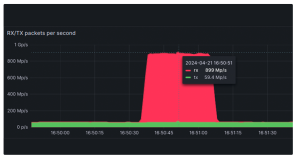Companies are constantly under attack from various threats. One of the more prevalent forms of DDoS (Distributed Denial of Service) attacks that can cripple systems is the ACK Flood attack. But what exactly is it, and how does it impact your network? Let’s break it down and explore the key things you need to know.
What is an ACK Flood Attack?
An ACK Flood is a type of denial-of-service (DoS) attack that targets the Transmission Control Protocol (TCP).
 The idea behind the attack is fairly simple: flood a server with an overwhelming number of ACK packets, which are part of the TCP handshake. This leads to congestion and ultimately disrupts the normal functioning of the server.
The idea behind the attack is fairly simple: flood a server with an overwhelming number of ACK packets, which are part of the TCP handshake. This leads to congestion and ultimately disrupts the normal functioning of the server.
Understanding TCP and the Three-Way Handshake
To truly understand how an ACK Flood works, it’s important to first have a brief grasp on how TCP works. TCP is a connection-oriented protocol that ensures reliable communication between two devices on a network. The three-way handshake. consists of the following steps:
- SYN: The client sends a synchronization packet to initiate the connection.
- SYN-ACK: The server responds with an acknowledgment and its own synchronization packet.
- ACK: The client sends an acknowledgment back to the server and the connection is established.
The Flood attacks exploit this final phase of the handshake process. Attackers send a flood of ACK packets, tricking the system into processing them without completing the full handshake, leading to resource exhaustion.
How Does an ACK Flood Attack Work?
In an this type of attack, the attacker floods the target server with ACK packets that seem to come from valid clients. The attack is effective because these packets are designed to confuse the target system. The server expects to complete the handshake before acknowledging any data. In an ACK flood attack, the target’s resources are overloaded. Thus the systems are attempting to process the false requests.
The Consequences of an ACK Flood
The consequences of an ACK flood can be severe. Let’s see what could happens when a system is flooded with ACK packets?
- Network congestion: Legitimate traffic can be delayed or dropped.
- Server crashes: A server may become overwhelmed and stop responding to requests, disrupting services.
- Resource exhaustion: The server or network device may consume significant resources trying to process an impossible number of requests.
Ultimately, the attack aims to make the target system unavailable to legitimate users, disrupting operations for businesses, customers, and anyone relying on the service.
How to Defend Against an ACK Flood Attack
Attacks can not be 100% prevented. But, there are several steps you can take to minimize the risk.
- Traffic Filtering: Use firewalls and intrusion prevention systems (IPS) to filter out abnormal traffic patterns, like high volume of ACK packets.
- Rate Limiting: Implement some kind of rate limiting on the servers.
- Load Balancers: Distribute incoming traffic across multiple servers to avoid overloading any single server.
- DDoS Protection Services: Implement DDoS protection service that can identify and mitigate such attacks before they cause serious damage.
- TCP SYN Cookies: Use SYN cookies to protect your servers against resource exhaustion from incomplete handshakes.
By implementing these defensive measures, you can significantly reduce the impact of an ACK flood and other similar attacks.
Final Thoughts
Understanding and defending against attacks like the ACK Flood is crucial for any organization. Cyber security plays an important part in every organization. For more information on how important is cyber security at this time, you can check: The importance of CyberSecurity Today
So, DDoS attacks, including ACK floods, are becoming more common and sophisticated, targeting vulnerabilities in critical systems.



